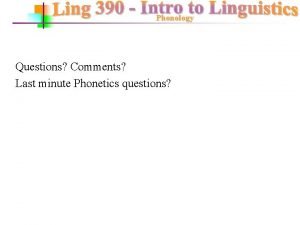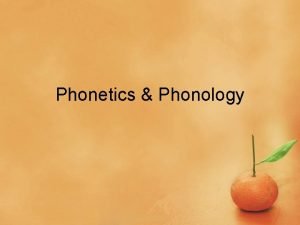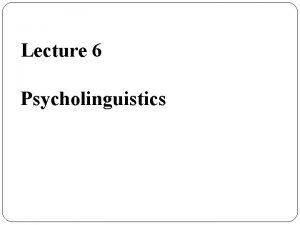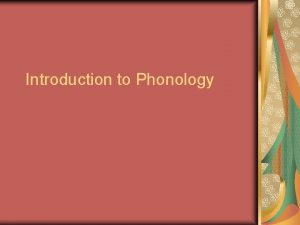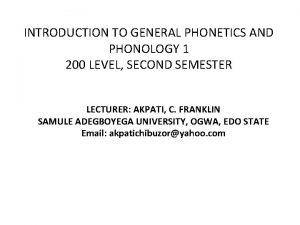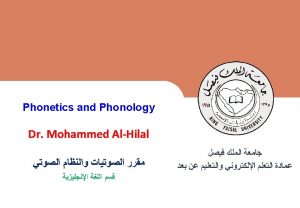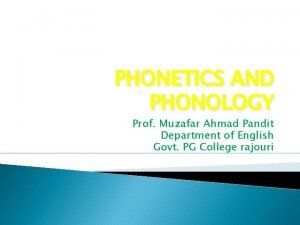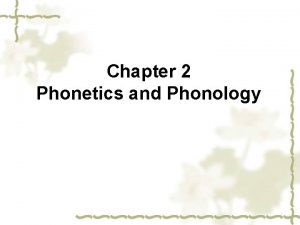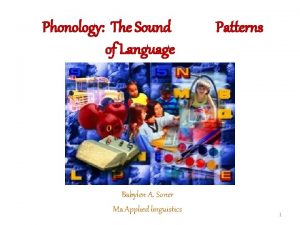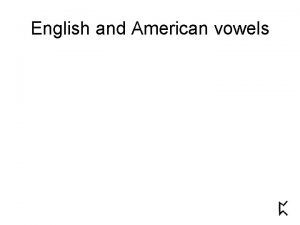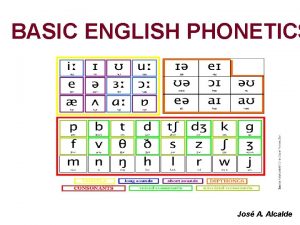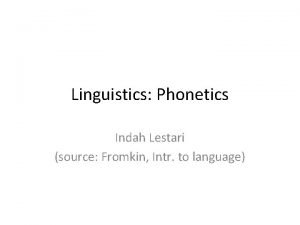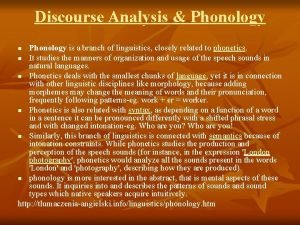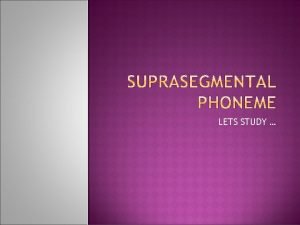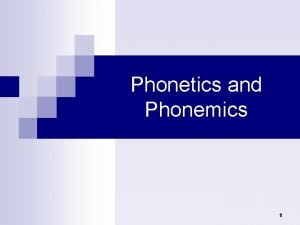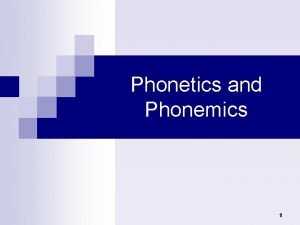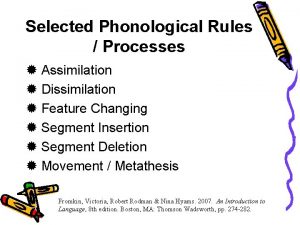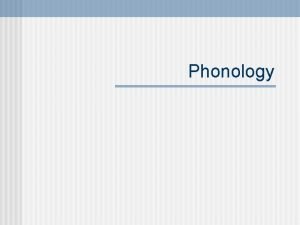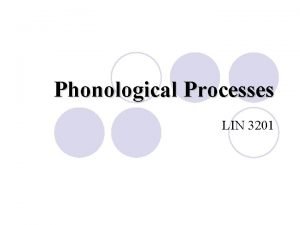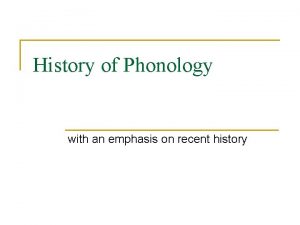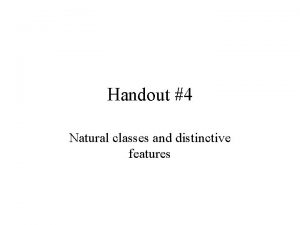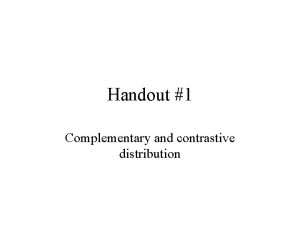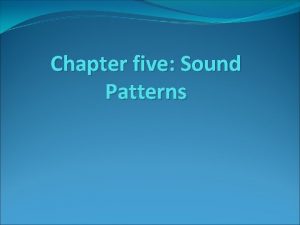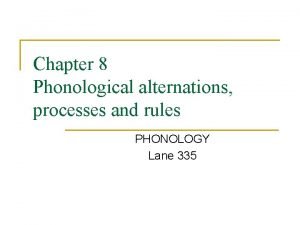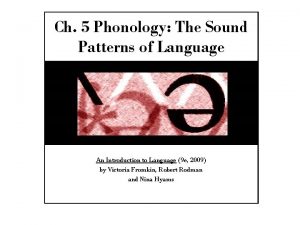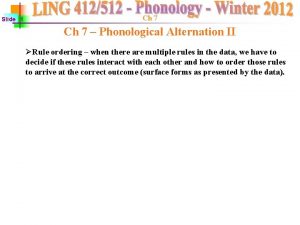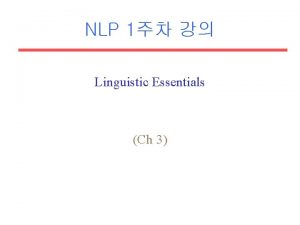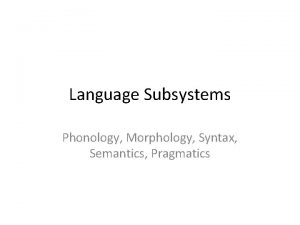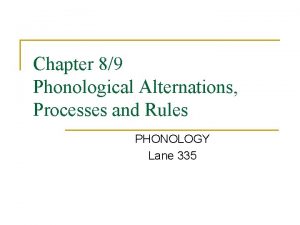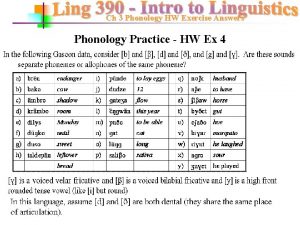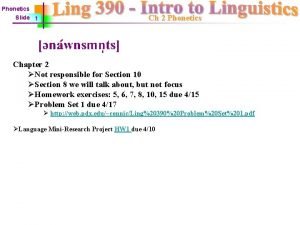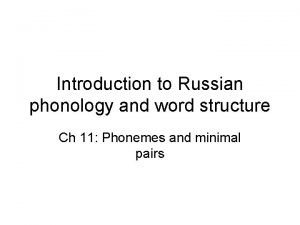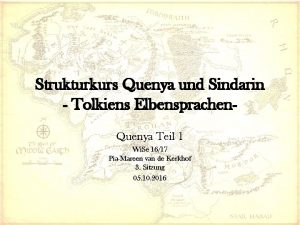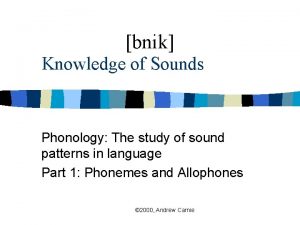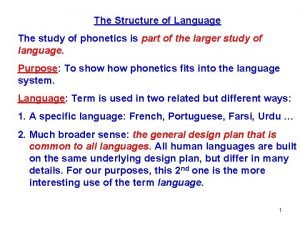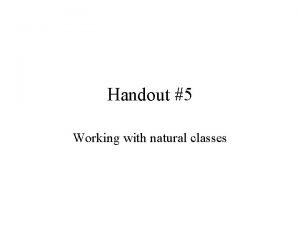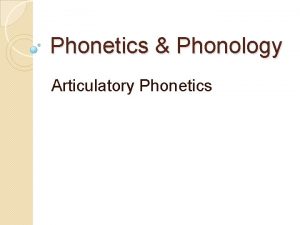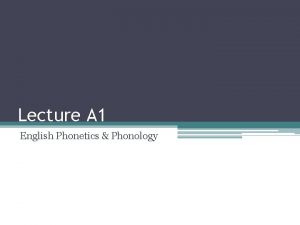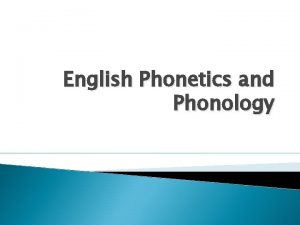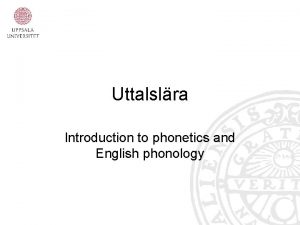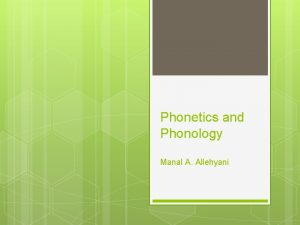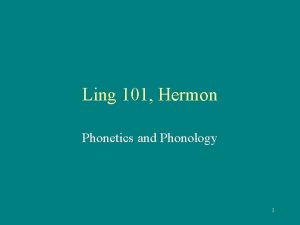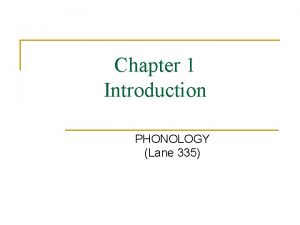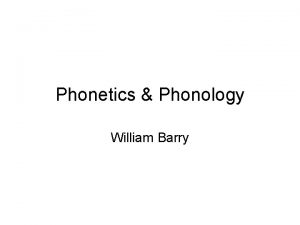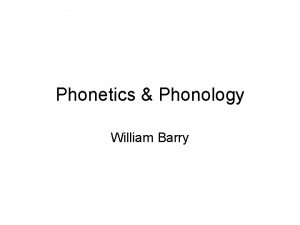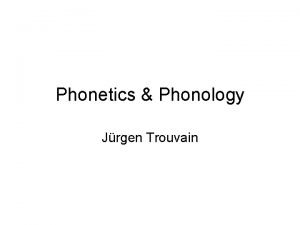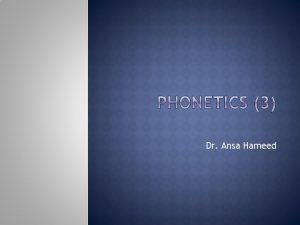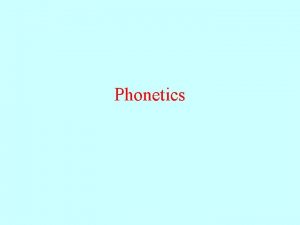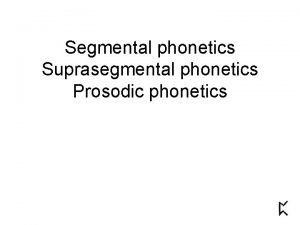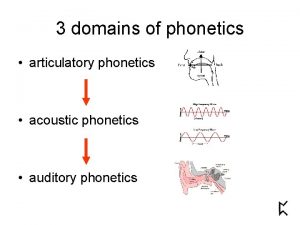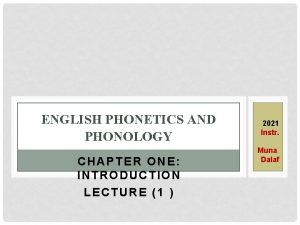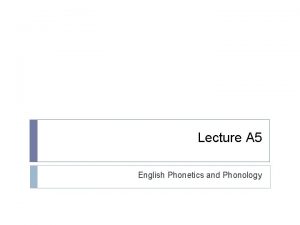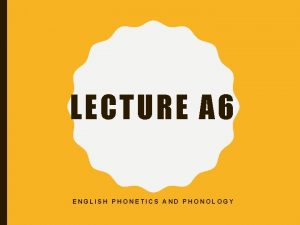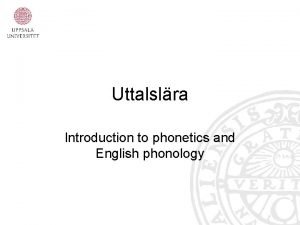LECTURE A 2 ENGLISH PHONETICS AND PHONOLOGY ITS


















![OTHER EXAMPLES: • Standard English does not… – Make the Spanish [j] as in OTHER EXAMPLES: • Standard English does not… – Make the Spanish [j] as in](https://slidetodoc.com/presentation_image_h2/6789c650bf4f2986d627157c1bdeeaa3/image-19.jpg)








![TEA & BUTTON • Hopefully… • …you pronounce these [T] sounds differently. • Tea TEA & BUTTON • Hopefully… • …you pronounce these [T] sounds differently. • Tea](https://slidetodoc.com/presentation_image_h2/6789c650bf4f2986d627157c1bdeeaa3/image-28.jpg)





















- Slides: 49

LECTURE A 2 ENGLISH PHONETICS AND PHONOLOGY

IT’S TIME TO LEARN SOME KEY TERMS. • The following vocabulary is essential for understanding and talking about English phonetics and phonology.

PHONETICS? PHONOLOGY? • Study of sound in human language (Phonetics). • The study of the selection and patterns of sounds in a single language (Phonology).

LET’S REVIEW… • How do we make sounds? • Moving the tongue, lips and other speech organs… = articulations • Maybe you’ve heard this term before… – When someone tests your speaking, they check for: • Proficiency (you can communicate content) • Fluency (smoothness, comfort with the language) • Articulation (ability to correctly make sounds) – We use this with “native speakers” also – “The CEO is very intelligent and he saved the business. However, he isn’t very articulate when he speaks on TV. ”

DIFFERENT TYPES OF PHONETICS. • Linguistics is a large subject… • And so is phonetics. • Three main areas: – Articulatory phonetics (using speech organs) – Auditory phonetics (how we hear sounds) – Psycholinguistics (how the brain interprets sounds)

OUR COURSE… • …will survey all three branches of phonetics… • …but focus mainly on articulatory phonetics and auditory phonetics • Articulatory Textbook • Auditory Extra exercises

LOOK AT YOUR PARTNER • One person speaks, the other listens (then switch). Read the follow words: – Mother – Mate – Moose – Mild – Morning – March

“M” • Sound is made with… – Lips (bilabial) – Air escaping the nose (nasal) – Voice is used (voiced) – The opposite of voiced is ______. – When we talk about making sounds we will use these (***) terms used in parenthesis. Be sure to memorize them!

“T” • What do we need to do to make a “T” sound? • Is it short or long?

“T” • Tongue-tip against the teeth ridge (alveolar) • Air escapes from mouth (NOT the nose) (oral) • Without voice (voiceless)

TYPES OF SYMBOLS • In the study of sound we use two types of symbols: – Phonetics symbols (from the IPA) – Orthographic symbols (regular spelling)

PHONETIC SYMBOLS

ORTHOGRAPHIC SYMBOLS

ENGLISH SPELLING • Is there a close connection between English pronunciation and spelling? • Why or why not? • How do you say these words: – Hospital – Knee – Fish

FISH

POTATO

CLICKS, LIP TRILLS… • https: //www. youtube. com/watch? v=JZ 6 oe 2 U 7 AOA

NO LANGUAGE… • …can produce or represent all the possible sounds the human speech apparatus can make. • Wow!
![OTHER EXAMPLES Standard English does not Make the Spanish j as in OTHER EXAMPLES: • Standard English does not… – Make the Spanish [j] as in](https://slidetodoc.com/presentation_image_h2/6789c650bf4f2986d627157c1bdeeaa3/image-19.jpg)
OTHER EXAMPLES: • Standard English does not… – Make the Spanish [j] as in “jefe” – Or the French [fw] sound as in “foi” (faith)

PHONEMES • To analyze speech, we must segment it. • This is also called segmentation. • To segment speech means to divide into smaller parts. • This is different from syllables (don’t confuse them!)

HOW MANY SEGMENTS…? • Segments are smaller sounds of a word. • Man • Pan • Fan • What is the difference between these words?

MINIMAL PAIRS • A minimal pair is when words differ by one sound. • Man, Pan and Fan are minimal pairs. • They differ by one sound…

WITH YOUR PARTNERS… • Make minimal pairs by changing the first sound in the following words: – Hate – Pen – Kick – Sea – Down – Lane – Feet

WHEN YOU HAVE MANY MINIMAL PAIRS… • Ban, tan, ran, pan… (different first sound) • We called this a minimal set. • Why? • Because these similar sounding words can change in other ways… – Bat, tat, rat, pat (different ending sound) – Bun, ton, run, pun (different middle sound)

WHY DO THIS? WHY ANALYZE THIS? • This kind of ‘sound experimentation’ helps us understand which sound are most significant in a language. • Phonemes, then, are contrastive units of sound • Example: Man – How many phonemes?

WHEN WE LABEL SOUNDS (PHONEMES)… • Use / / • Man has three phonemes • /M/ae/n/ • In Standard English there are typically 20 vowel phonemes and 24 consonant phonemes.

WHAT? • 20 vowel sounds… • 24 consonant sounds… • How many letters in the English alphabet? • This is what gives English its range of sounds and variation between accents. • T: pronounce [tea] and then [button] – Are these [T] sounds the same of different? – Why?
![TEA BUTTON Hopefully you pronounce these T sounds differently Tea TEA & BUTTON • Hopefully… • …you pronounce these [T] sounds differently. • Tea](https://slidetodoc.com/presentation_image_h2/6789c650bf4f2986d627157c1bdeeaa3/image-28.jpg)
TEA & BUTTON • Hopefully… • …you pronounce these [T] sounds differently. • Tea (tongue-tip T) • Button (Glottal stop T)

TRY THESE WORDS WITH A PARTNER. • Kitten • Cotton Group 1 • Britain • Bottle • Rattle Group 2 • Brittle • Do you notice anything similar or different between word group 1 and 2?

HOW CAN I POSSIBLY LEARN PRONUNCIATION BY ANALYZING PHONEMES? ? ? • Phonemes are good to identify… • …But are very abstract. • You cannot produce a “phoneme”

ALLOPHONES • Allophones are the different sounds that represent a single phoneme. • Example: the aspirated k in kit and the unaspirated k in skit, which are allophones of the phoneme k.

PHONEME / ALLOPHONE • Phonemes are abstract • Allophones are the sounds that represent the phoneme. • We can write a phoneme, but can’t really pronounce it. • We can speak an allophone. Allophones are different ways to speak a written phoneme.

SPEAK THESE PHRASES TO A PARTNER. • John told Mary to stop the car • Stop and go • When you come to the sign, stop • Is the word stop spoken differently? • What are the phonemes? /s/t/ah/p – As a phoneme, /p/ is always the same • But when spoken the “p” sound… – Varies

IN SUM… • Phonemes are ABSTRACT sound units in a language. • Allophones are REAL sound units based on the phonemes in a language.

PRONUNCIATION… ENERGY? • When we make sounds, we use different amounts of energy. • Sometimes this energy is strong, other times this energy is weak. • Strong and weak energy consonants • /p/ & /b/ are good examples. • Both sounds are articulated the same way, but use different amounts of energy.

ENERGY (STRONG AND WEAK) • Is /p/ strong? Or /b/ ?

VOWELS! • Three groups of English vowels:

IN OTHER WORDS… • Short • Long (using lip and/or tongue) • You will see different symbols to write these in dictionaries (more on this later!)

SHORT LONG /

SO MUCH TO THINK ABOUT! • But wait! There is more! • Phonemes… • Allophones… • Consonants… • Vowels…

SYLLABLES! • How many syllables in this expression? • An elephant never forgets.

WHAT IT LOOKS LIKE…

SYLLABLES? WHY ARE THEY DIFFICULT? • Different languages ‘build’ syllables differently from their phonemes. • Syllable as a “unit” of sound is difficult to define. • A native speaker knows how many… but can have difficulty knowing where the syllables start and end. – Extract

SYLLABLE: • “Unit larger than the phoneme but smaller than the word. ” • So… a phoneme is the most basic sound element. • A syllable is the next level • Phoneme Syllable Word Phrase Sentence

WHAT’S IN A SYLLABLE?

WHAT’S IN A SYLLABLE? • Nucleus – Contains a vowel – Maybe one or more consonants on either side – Example: cat • 1 syllable • The /a/ is the vowel holding the syllable together

BUT SOMETIMES… • A consonant can be the nucleus of the syllable… • …/m, n, ng, l/ – Rhythm (2) – Subtle (2) – This happens because /m, n, ng, l/ sounds are longer than other consonants

HOMOPHONES • …words that sound the same, but are written differently. • …homo… = same • …phones… = sound • Bear, bare • Meat, meet • Some, sum • Sent, scent • Homophones are a major cause of spelling errors.

FIND THE ‘WRONG’ WORD AND REPLACE WITH ITS HOMOPHONE.
 Phoneme examples
Phoneme examples Difference between phonetics and phonology
Difference between phonetics and phonology Questions about phonetics
Questions about phonetics Phonetics and phonology
Phonetics and phonology A concise introduction to linguistics
A concise introduction to linguistics Drc model of reading
Drc model of reading Difference between phonetics and phonology
Difference between phonetics and phonology Introduction to general phonetics and phonology
Introduction to general phonetics and phonology Phonemes and symbols
Phonemes and symbols Elearning
Elearning Phonetics and phonology
Phonetics and phonology Dissimilation phonetics
Dissimilation phonetics S phonetic alphabet
S phonetic alphabet Onset coda nucleus
Onset coda nucleus American english phonology
American english phonology Basic english phonetics
Basic english phonetics Define phonetics in english
Define phonetics in english 01:640:244 lecture notes - lecture 15: plat, idah, farad
01:640:244 lecture notes - lecture 15: plat, idah, farad Discourse analysis and phonology
Discourse analysis and phonology Segmental and suprasegmental phonology examples
Segmental and suprasegmental phonology examples Phonetically pronunciation
Phonetically pronunciation Phonetics n
Phonetics n Form of emigree
Form of emigree Its halloween its halloween the moon is full and bright
Its halloween its halloween the moon is full and bright English literature lecture
English literature lecture English language lecture
English language lecture Dissimilation meaning
Dissimilation meaning Whats an allophone
Whats an allophone Phonology process
Phonology process Non segmental phonology
Non segmental phonology Autosegmental phonology
Autosegmental phonology Examples of fricatives
Examples of fricatives Contrastive vs complementary distribution
Contrastive vs complementary distribution Free variation and complementary distribution
Free variation and complementary distribution Phonology process
Phonology process Sound patterns examples
Sound patterns examples Alternation in phonology
Alternation in phonology Phonological features chart
Phonological features chart Phonology examples sentences
Phonology examples sentences Linking in phonology
Linking in phonology Morphology phonology syntax semantics pragmatics
Morphology phonology syntax semantics pragmatics Alpha notation phonology
Alpha notation phonology Phonology exercise
Phonology exercise Phonology process
Phonology process Russian allophones
Russian allophones Quenya phonology
Quenya phonology Free variation and complementary distribution
Free variation and complementary distribution Recursion language
Recursion language Minimal pairs examples
Minimal pairs examples Natural classes in phonology
Natural classes in phonology


